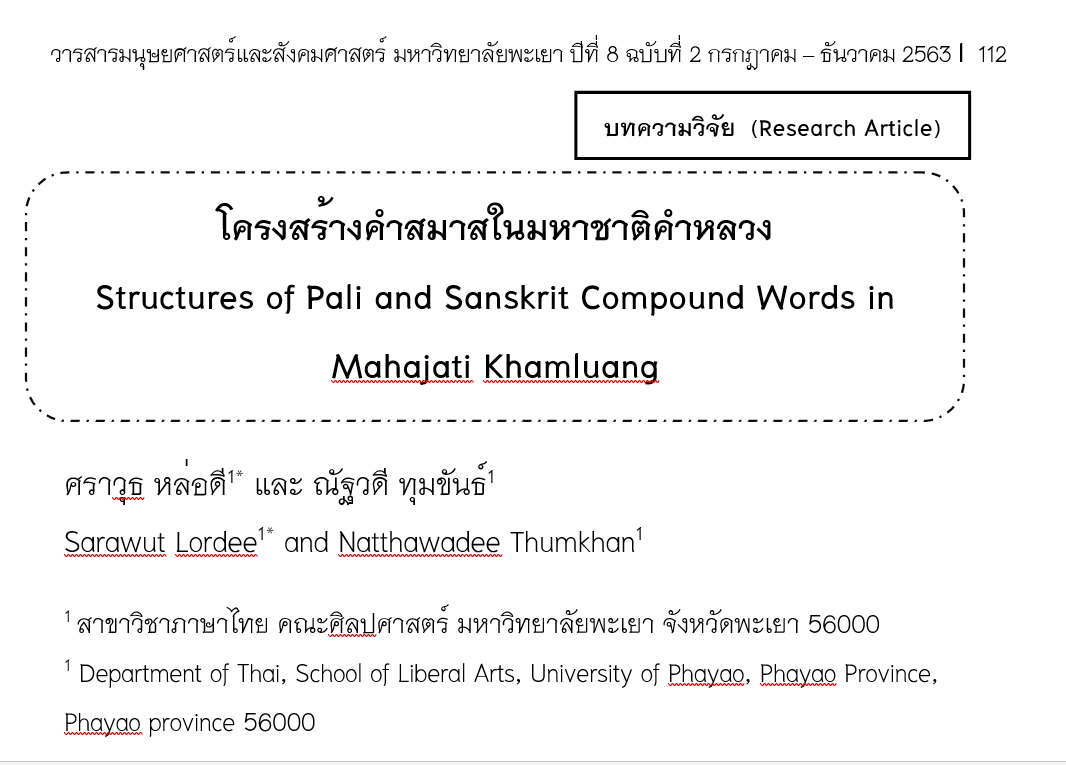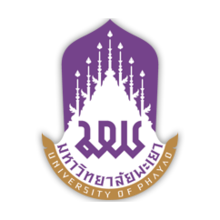Structures of Pali and Sanskrit Compound Words in Mahajati Khamluang
Keywords:
Structure, Pali and Sanskrit Compound Words, Mahajati KhamluangAbstract
This research aims to analyze structures of Pali and Sanskrit compound Words (samasa words) in Mahajati Khamluang in terms of numbers of combined words, word formations, and parts of speech of combined words. Data were collected from a glossary of Thai literature dictionary in the Ayutthaya period ‘Mahajati Khamluang’ published by the Royal Institute. The glossary is alphabetized from a Thai consonant letter ‘ko kai’ to ‘ho nok huk’ (ก-ฮ). There were 107 compound words and their structures were analyzed. The results of this research were presented in descriptive method with statistics.
The study indicated that the structures of compound words can be classified into 3 groups: 1) two-word compound words which were divided into 5 main types 2) three-word compound words which were divided into 7 main types 3) four-word compound words which were divided into 2 main types. The structure mostly found of each group was namely 1) noun + noun 2) noun + noun + noun 3) noun + noun + noun + adjective and adjective + noun + adjective + noun. Considering the proportion of three groups of compound words structures, it was found that the structure of two-word compound words was the largest proportion. Three-word compound words and four-word compound words were ranked second and third respectively.
References
จงชัย เจนหัตถการกิจ. (2551). หลักภาษาไทย (พิมพ์ครั้งที่ 12). กรุงเทพฯ: ธนาเพรส.
จันจิรา เซี่ยงฉิน. (2550). คำสมาสในพจนานุกรม ฉบับราชบัณฑิตยสถาน พ.ศ. 2542. วิทยานิพนธ์ศิลปศาสตรมหาบัณฑิต (ศศ.ม.), มหาวิทยาลัยนเรศวร, พิษณุโลก.
ณัฐา วิพลชัย. (2558). ลักษณะคำยืมภาษาบาลีสันสกฤตในวรรณกรรมท้องถิ่นภาคใต้เรื่อง พระมหาชาดกคำกาพย์. วารสารมนุษยศาสตร์และสังคมศาสตร์ มหาวิทยาลัยราชภัฏสุราษฎร์ธานี, 7(2), 17-45.
นววรรณ พันธุเมธา. (2558). ไวยากรณ์ไทย (พิมพ์ครั้งที่ 7). กรุงเทพฯ: โครงการเผยแพร่ผลงานวิชาการ คณะอักษรศาสตร์ จุฬาลงกรณ์มหาวิทยาลัย.
บัญญัติ สาสี. (2553). คำยืมภาษาเขมรในภาษาไทย: กรณีศึกษามหาชาติคำหลวง. วิทยานิพนธ์ศิลปศาสตรดุษฎีบัณฑิต (ศศ.ด.), มหาวิทยาลัยนเรศวร, พิษณุโลก.
พระมหาสาโรจน์ บัวพันธุ์งาม. (2552). การวิเคราะห์คำสมาสในพจนานุกรม ฉบับราชบัณฑิตยสถาน พ.ศ. 2542. วิทยานิพนธ์ศิลปศาสตรมหาบัณฑิต (ศศ.ม.), มหาวิทยาลัยศรีนครินทรวิโรฒ, กรุงเทพฯ.
พระยาอุปกิตศิลปสาร. (2545). หลักภาษาไทย: อักขรวิธี วจีวิภาค วากยสัมพันธ์ ฉันทลักษณ์ (พิมพ์ครั้งที่ 11). กรุงเทพฯ: ไทยวัฒนาพานิช.
มูลนิธิสมเด็จพระเทพรัตนราชสุดา. (2553). นามานุกรมวรรณคดีไทย ชุดที่ 1 ชื่อวรรณคดี (พิมพ์ครั้งที่ 4). กรุงเทพฯ: แปลนพริ้นติ้ง.
ราชบัณฑิตยสถาน. (2549). พจนานุกรมศัพท์วรรณคดีไทย สมัยอยุธยา มหาชาติคำหลวง. นนทบุรี: สหมิตรพริ้นติ้ง.
ราชบัณฑิตยสถาน. (2556). พจนานุกรม ฉบับราชบัณฑิตยสถาน พ.ศ. 2554 (พิมพ์ครั้งที่ 2). กรุงเทพฯ: ศิริวัฒนาอินเตอร์พริ้นท์.
วัลยา ช้างขวัญยืน. (2549). หนังสืออุเทศภาษาไทย ชุด บรรทัดฐานภาษาไทย เล่ม 2: คำ การสร้างคำและการยืมคำ. กรุงเทพฯ: โรงพิมพ์คุรุสภาลาดพร้าว.
วิจินตน์ ภาณุพงศ์. (2534). โครงสร้างของภาษาไทย: ระบบไวยากรณ์ (พิมพ์ครั้งที่ 11). กรุงเทพฯ: สำนักพิมพ์มหาวิทยาลัยรามคำแหง.
ศราวุธ หล่อดี. (2558). คำยืมภาษาสันสกฤตในนิทานเวตาล. วารสารมนุษยศาสตร์และสังคมศาสตร์ มหาวิทยาลัยพะเยา, 3(2), 30-41. ได้จาก: https://so03.tci-thaijo.org/index.php/Humanties-up/article/view/200560/140196
สยาม ภัทรานุประวัติ. (2550). ภาษาบาลีและสันสกฤตในภาษาไทย. เชียงใหม่: ภาควิชาภาษาไทย คณะมนุษยศาสตร์ มหาวิทยาลัยเชียงใหม่.
อมรา ประสิทธิ์รัฐสินธุ์. (2548). ภาษาในสังคมไทย: ความหลากหลาย การเปลี่ยนแปลง และการพัฒนา (พิมพ์ครั้งที่ 4). กรุงเทพฯ: โรงพิมพ์แห่งจุฬาลงกรณ์มหาวิทยาลัย.
อารีย์ สหชาติโกสีย์. (2521). เทียบลักษณะคำบาลีสันสกฤตกับคำไทย สมาสและตัทธิต. กรุงเทพฯ: คณะมนุษยศาสตร์ มหาวิทยาลัยศรีนครินทรวิโรฒ.

Downloads
Published
How to Cite
Issue
Section
License
ผู้นิพนธ์ต้องรับผิดชอบข้อความในบทนิพนธ์ของตน มหาวิทยาลัยพะเยาไม่จำเป็นต้องเห็นด้วยกับบทความที่ตีพิมพ์เสมอไป ผู้สนใจสามารถคัดลอก และนำไปใช้ได้ แต่จะต้องขออนุมัติเจ้าของ และได้รับการอนุมัติเป็นลายลักษณ์อักษรก่อน พร้อมกับมีการอ้างอิงและกล่าวคำขอบคุณให้ถูกต้องด้วย
The authors are themselves responsible for their contents. Signed articles may not always reflect the opinion of University of Phayao. The articles can be reproduced and reprinted, provided that permission is given by the authors and acknowledgement must be given.







